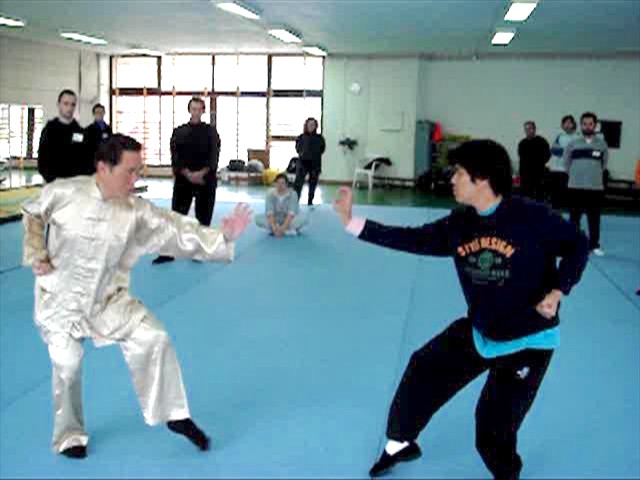HOW DO WE ASSERTAIN THAT WHAT WE PRACTICE IS SHAOLIN KUNGFU?

The forms used by Grandmaster Wong (left) and Sifu Wong Chun Nga are typical Shaolin.
Question
I was not unaware of the fighting style of kungfu or even of Shaolin, but of the exercises, principles, theories, and knowledge, you don't see them as in the movies.
— Clayton, USA
Answer
Why don't you see the exercises, principles, theories and knowledge of kungfu, especially Shaolin, in real life as you see them in movies or in books? The reason is simple, though most people refuse to relate to it. Kungfu, especially Shaolin Kungfu as I understand it, is very, very rare today.
What criteria can we use to ascertain whether the “kungfu” in question is real kungfu? Again this is simple. The amazing thing is that most people fail, or refuse, to see it. Virtually everyone who practices kungfu or reads about it, will agree that kungfu enables you to defend yourself, and gives you good health.
Yet, most of the so-called kungfu exponents today, including some masters, cannot efficiently use the kungfu they have ardently practiced to defend themselves, though they may be, and many actually are, formidable fighters using techniques of other martial systems. Moreover, many of them do not have good health, especially emotional health. If you cannot defend yourself with your art and are not healthy, how can you call your art kungfu?
The kungfu, or wushu as the Chinese call it, coming out from China today is no longer a martial or even a health-care art, as many of the practitiners suffer from arthritis and depression. I even question whether international wushu champions can effectively defend themselves against street dogs, leave aside street fighters. This is no slight on them. Most people untrained in martial arts cannot defend themselves against dogs, and Chinese wushu practitioners explicitly state that they are not practicing a martial art.
After we have ascertained that a particular kungfu style is real kungfu, then how do we ascertain it is genuine Shaolin Kungfu? Again we go back to classical authority. Past masters mentioned three criteria for assessment: lineage, philosophy and practice.
I would add a fourth criterion, namely result. Past masters did not consider this fourth factor because result was taken for granted. If one practiced kungfu he would be able to defend himself, if one practiced chi kung he would be healthy. Interestingly, today it is usually not the case.
However, although lineage was the most important factor in the past, it may not be valid today! In the past, if one was lucky to have a distinguished lineage, it was almost certain that his attainment in the art was high. But situations have changed. Today even the kungfu of many grandchildren and great grandchildren of established past masters has degraded into demonstrative forms.
Let us examine the other criteria.
In Shaolin philosophy, kungfu is not just for fighting and good health, but leads to the highest spiritual fulfillment. In Shaolin practice, its training system is complete and holistic. Hence, if someone stresses that there is nothing spiritual in his Shaolin Kungfu, I would suspect whether he understands Shaolin philosophy. If someone uses weight-lifting to develop power, and knows nothing about chi kung or a meditative state of mind, I would suspect whether his is genuine Shaolin practice.
The fourth criterion, result, dictates that it is insufficient just to talk about Shaolin philosophy and undergo Shaolin practice. His philosophy and practice must produce the expected result. If he talks about chi kung and meditation, and actually practice them, but he is still weak and dull, I would also suspect whether his is genuine chi kung or genuine Shaolin Kungfu.
Some other great kungfu styles may also have similar philosophical and methodological considerations. Taijiquan, for example, also aims for spiritual fulfillment, and its practice is also complete and holistic. How do we ascertain it is genuine Shaolin, Taijiquan or another great kungfu style?
We examine its typical forms and methods of training. Shaolin Kungfu, for example, typically uses forms and methods like Golden Bridge and Zen, whereas Taijiquan uses Three-Circle Stance and flowing movement.
The above is taken from Question 3 of April 2002 Part 1 of the Selection of Questions and Answers.
LINKS
Courses and Classes
